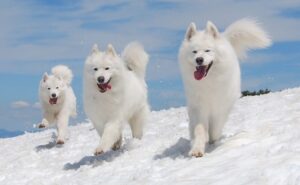All About Samoyed Dogs: The Ultimate Guide to the Smiling Sammies

The Samoyed dog, often affectionately referred to as a “Sammie” or “Smiling Sammie,” is a breed known for its friendly disposition, fluffy white coat, and iconic smile. Originating from the Siberian regions of Russia, these dogs have a rich history and are cherished for their companionship, work ethic, and beauty. This comprehensive guide delves into everything you need to know about Samoyeds, from their history and characteristics to their care and training.
History of the Samoyed Dog
Origins and Early Use
Samoyeds are named after the Samoyedic people, a nomadic group in Siberia who relied on these dogs for herding reindeer, pulling sleds, and keeping them warm in the harsh Arctic climate. These dogs were integral to the Samoyedic way of life, known for their strength, endurance, and ability to form close bonds with humans.
Introduction to the West
In the late 19th and early 20th centuries, Samoyeds were brought to England and other parts of Europe, where they quickly gained popularity. Their striking appearance and friendly nature made them favorites among dog enthusiasts and explorers. Notably, Samoyeds were used in various polar expeditions, including those led by Fridtjof Nansen and Roald Amundsen, who praised their resilience and reliability.
Characteristics of the Samoyed Dog
Appearance
Samoyeds are medium to large-sized dogs with a robust and muscular build. They are easily recognizable by their dense, double-layered coat, which is typically white but can also be cream or biscuit. Their eyes are almond-shaped and usually dark, complementing their expressive, smiling faces. One of their most distinctive features is their thick, plumed tail, which curls over their back.
- Height: 19 to 23.5 inches (48 to 60 cm)
- Weight: 35 to 65 pounds (16 to 30 kg)
Temperament
Samoyeds are known for their friendly and gentle nature. They are social dogs that thrive on human interaction and are great with children and other pets. Their intelligence and eagerness to please make them relatively easy to train, although their independent streak can sometimes require patience and consistency from their owners.
Lifespan
With proper care, Samoyeds typically live between 12 to 14 years. Regular veterinary check-ups, a balanced diet, and adequate exercise contribute to their overall health and longevity.
Care and Maintenance
Grooming
Samoyeds have a thick double coat that requires regular grooming to keep it clean and free of mats. Weekly brushing is essential, and during shedding season, more frequent brushing may be necessary to manage the fur. Despite their fluffy appearance, Samoyeds are relatively low-odor dogs, and their coat has a self-cleaning quality.
- Bathing: Every 3-4 months, or as needed
- Brushing: At least once a week
- Nail Trimming: Monthly
Diet and Nutrition
A balanced diet is crucial for maintaining a Samoyed’s health. High-quality dog food, whether commercial or homemade, should be appropriate for the dog’s age, size, and activity level. Samoyeds can be prone to obesity, so it’s important to monitor their weight and adjust their diet accordingly.
Exercise Needs
Samoyeds are active dogs that require regular exercise to stay healthy and happy. Daily walks, playtime in the yard, and engaging in activities like hiking, agility, or obedience training can help meet their exercise needs. Due to their working heritage, they also enjoy pulling activities like sledding or carting.
Training and Socialization
Early Socialization
Early socialization is key to raising a well-adjusted Samoyed. Exposure to different people, places, sounds, and experiences during puppyhood helps prevent behavioral issues and ensures that they grow up to be confident, friendly adults.
Basic Training
Samoyeds are intelligent and eager to please, making them generally responsive to training. Positive reinforcement methods, such as treats and praise, work best. Consistency and patience are important, as their independent nature can sometimes make them seem stubborn.
Advanced Training
For those interested in further training, Samoyeds excel in various dog sports and activities. Agility, obedience, herding, and even therapy work are great ways to challenge their minds and bodies.
Health Concerns
Common Health Issues
Like all breeds, Samoyeds are prone to certain health issues. Responsible breeders screen for conditions such as hip dysplasia, progressive retinal atrophy (PRA), and hypothyroidism. Regular veterinary care and a healthy lifestyle can help mitigate these risks.
- Hip Dysplasia: A genetic condition that affects the hip joints.
- Progressive Retinal Atrophy (PRA): An eye disorder that can lead to blindness.
- Hypothyroidism: A condition where the thyroid gland doesn’t produce enough hormones.
Preventative Care
Routine veterinary check-ups, vaccinations, and parasite prevention are essential for maintaining a Samoyed’s health. Additionally, maintaining a healthy weight and providing regular exercise can help prevent many common health issues.
Why Choose a Samoyed?
Samoyeds are wonderful companions for the right families. Their friendly nature, intelligence, and loyalty make them excellent pets for those who can meet their grooming, exercise, and social needs. They thrive in active households where they can be part of daily activities and enjoy plenty of attention and love.
Conclusion
A Samoyed dog is a remarkable breed with a rich history and a bright future. Their beautiful appearance, combined with their loving and gentle nature, makes them a beloved choice for dog enthusiasts around the world. Whether you’re looking for a family pet, a working dog, or a loyal companion, the Samoyed is a breed that will bring joy and companionship for many years to come. By understanding their needs and providing proper care, you can ensure that your Samoyed leads a happy, healthy, and fulfilling life
